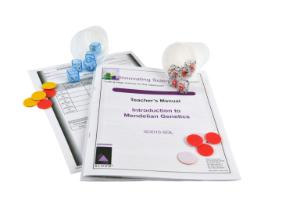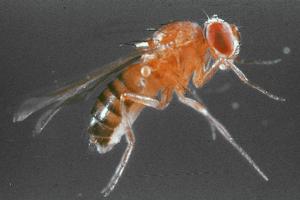Explore Mendelian Genetics; Plus a free student handout from AccessScience
Access to this article is being offered to Ward's World readers for free from McGraw Hill's AccessScience. An award-winning gateway to scientific knowledge, AccessScience offers exclusive articles written by prominent scientists, links to primary research material, videos and animations, plus faculty-designed curriculum maps for teachers. To see more content like this, learn about subscription options, and request a free trial for your school, click here.
The team at Ward's World is excited to make available this powerful series of science articles from McGraw Hill's AccessScience. This unique series fits our mission to find ways to bring you tips, ideas, and resources to help inspire students and guide discovery and learning. Look for a new McGraw Hill's AccessScience article to be posted each month on Ward's World.
Gregor Johann Mendel, born on July 20, 1822, is known for discovering the principles that rule heredity by breeding pea plants in his monastery's garden. Mendelism is a common entry point for learning about genetics in basic biology classes. Educators build lessons around scientific inquiry, methodology, classical genetics, and plant biology. Students can learn how recessive and dominant traits behave from generation to generation; all they have to do is "give peas a chance!"
These days, scientists know a lot more about genetics and heredity. And there are many other ways in which some characteristics are inherited. But it all started with Mendel and his peas. Dr. Michael F. Murray, clinical director of the Yale Center for Genomic Health, said, "Thanks to Mendel's work, we can interview a patient in our adult genetics clinic tomorrow, generate a pedigree, track a disease through multiple generations in a family, interpret the pedigree as autosomal dominant (or recessive, or x-linked), and then – if we are correct in our interpretation – we can be confident that a single mutated gene is at work in the patient's family."
This article can help you prepare lessons that include Mendel's laws of heredity, inherited traits in plants, and analyzing how biological traits are passed on to successive generations.
Mendelism
Original Article by: Michael R. Cummings, Department of Biological Sciences, University of Illinois, Chicago, Illinois.
Content
Key Concepts
- Gregor Johann Mendel, an Augustinian monk, formulated the fundamental principles governing the transmission of genetic traits. The term Mendelism describes these basic laws of genetic inheritance.
- Mendel's work, which has been confirmed by genetic crosses and breeding applications with many different organisms, is regarded as the beginning of genetics as an organized scientific discipline.
- Mendel proposed that each plant (the organism that he studied) contains a pair of factors (genes) for each trait. The trait that is expressed in the first filial generation (F1) is controlled by a dominant factor, whereas the unexpressed trait is controlled by a recessive factor.
- The most simple Mendelian cross, called a monohybrid cross, involves only one pair of traits. A cross that involves two pairs of contrasting traits is known as a dihybrid cross.
- Mendel postulated that factors (genes) separate or segregate from each other during gamete (sex cell) formation.
- The traits of offspring are determined by segregation, independent assortment, and random fertilization.
Fundamental principles governing the transmission of genetic traits, as discovered by Gregor Mendel. Mendelism is the term used to describe the basic laws of genetic inheritance (Fig. 1). These operating laws were formulated by Gregor Johann Mendel (1822–1884), an Augustinian monk, who conducted a number of notable experiments on plant hybrids. Mendel published his scientific work in 1866; however, it went largely unheralded until 1900, when other investigators performed similar hybridization experiments and brought his work to the attention of the scientific world. The rediscovery of his work is regarded as the beginning of genetics as an organized discipline. Since then, genetic crosses and breeding endeavors with many different organisms have confirmed the fundamental nature and significance of Mendel's work.
Fig. 1 Schematic representation of a monohybrid cross. Pure-bred yellow and green pea strains are crossed and yield a typical 3:1 ratio (3 yellow and 1 green) in the F2 generation. Y and y represent the yellow and green factors (genes), respectively. P represents the parent generation, F1 represents the first filial generation, and F2 represents the second filial generation. (Copyright © McGraw Hill)
In 1856, Mendel performed his first set of hybridization experiments with pea plants in the monastery garden at Brno, Moravia (now part of the Czech Republic). Although the pea plant is normally self-fertilizing, it can be easily crossbred and grows to maturity in a single season. True breeding strains, each with distinct characteristics, were available from local seed merchants. For his experiments, Mendel chose seven sets of contrasting characters or traits—stem height, seed shape and color, pod shape and color, flower color, and flower location on the plant stem (Fig. 2).
Fig. 2 The seven sets of contrasting characters or traits studied by Gregor Johann Mendel. (Copyright © McGraw Hill)
The most simple crosses performed by Mendel involved only one pair of traits; each such experiment is known as a monohybrid cross (Fig. 1). The plants used as parents in these crosses are known as the P1 (first parental) generation. For example, when plants yielding yellow seeds (peas) were crossed with plants yielding green seeds (peas), all of the resulting offspring (called the F1 or first filial generation) yielded yellow peas. When members of the F1 generation were self-crossed, approximately three-fourths of the resulting F2 (second filial generation) plants yielded yellow peas and one-fourth yielded green peas (a 3:1 ratio). The yellow-colored trait is expressed in both the F1 and F2 generations, whereas the green-colored trait disappears in the F1 generation and reappears in the F2 generation. The trait expressed in the F1 generation is called the dominant trait; in contrast, the recessive trait is unexpressed in the F1, but reappears in the F2. Mendel made similar crosses with plants exhibiting each of the other pairs of traits that he studied; in each case, all of the F1 offspring showed only one of the parental traits and, in the F2, three-fourths of the plants showed the dominant trait and one-fourth exhibited the recessive trait. In subsequent experiments, Mendel found that the F2 recessive plants bred true; among the dominant plants, one-third bred true and two-thirds behaved like the F1 plants.
To explain the results of his monohybrid crosses (Fig. 1), Mendel derived several postulates. First, he proposed that each of the traits is controlled by a factor (later to be called a gene). Because the F1 plants in the aforementioned example produce both yellow- and green-colored seed offspring, they must contain a factor for each; thus, Mendel proposed that each plant contains a pair of factors for each trait. Second, the trait that is expressed in the F1 generation is controlled by a dominant factor, whereas the unexpressed trait is controlled by a recessive factor. To prevent the number of factors from being doubled in each generation, Mendel postulated that factors must separate or segregate from each other during gamete (sex cell) formation. Therefore, the F1 plants can produce two types of gametes—one type containing a dominant factor and the other type containing a recessive factor. At fertilization, the random combination of these gametes can explain the types and ratios of offspring in the F2 generation.
Mendel extended his experiments to examine the inheritance of two characters simultaneously. Such a cross, involving two pairs of contrasting traits (such as seed color and seed shape), is known as a dihybrid cross (Fig. 3). For example, Mendel crossed pea plants yielding yellow-colored and round-shaped seeds with plants yielding green-colored and wrinkled-shaped seeds. All of the F1 offspring yielded yellow-colored and round-shaped seeds. When the F1 individuals were self-crossed, four types of offspring were produced in the following proportions—9/16: yellow and round; 3/16: green and round; 3/16: yellow and wrinkled; 1/16: green and wrinkled. This 9:3:3:1 ratio is known as the dihybrid ratio.
Fig. 3 Schematic representation of a dihybrid cross. In this example, pea plants with contrasting seed color and seed shape are crossed. Specifically, plants yielding yellow-colored and round-shaped seeds are crossed with plants yielding green-colored and wrinkled-shaped seeds. The resultant 9:3:3:1 ratio of the offspring is known as the dihybrid ratio. (Copyright © McGraw Hill)
On the basis of similar results in other dihybrid crosses, Mendel proposed that, during gamete formation, segregating pairs of factors assort independently of one another. As a result of segregation, each gamete receives one member of every pair of factors [this assumes that the factors (genes) are located on different chromosomes]. As a result of independent assortment, all possible combinations of gametes will be found in equal frequency. In other words, during gamete formation in the aforementioned example, round and wrinkled factors segregate into gametes independently of whether they also contain yellow or green factors. Thus, the 9:3:3:1 ratio is the result of segregation, independent assortment, and random fertilization.
This article was originally published by McGraw Hill's AccessScience. Click here to view and find more articles like this.
Download this article as a PDF to share with your students:
For more ways to explore this topic with your students, check out these recommended materials:
[StartProductBlock]

Ward's® Principles of Mendelian Genetics Lab Activity
Students can observe the results of random genotype combinations with the same mathematical results as in living organisms, but without the hassle of growing them. Demonstrate probability and the laws of Segregation and Independent Assortment. Pre- and post-laboratory assessments and links to real world concepts.
[EndProductBlock]
[StartProductBlock]

Introduction to Mendelian Genetics - Small Group Learning Kit
Students can simulate Mendel's Work and determine patterns of inheritance. Using special chips and Innovating Science’s exclusive “double dice,” students will be able to simulate both monohybrid and dihybrid crosses.
[EndProductBlock]
[StartProductBlock]

Ward's® Drosophila Genetics Project Lab Activity
Perform a variety of investigations utilizing Drosophila melanogaster crosses. Teacher developed and tested, this lab helps teach monohybrid, dihybrid, and sex-linked crosses; epistasis; crossover; linkage; three-point chromosome mapping; and more.
[EndProductBlock]
[StartProductBlock]

Drosophila Sets, Live Fruit Flies
Drosophila melanogaster, the common fruit fly, is widely used in genetic studies. Students can study sex-linked, recessive, and dominant mutations. Drosophila also makes an excellent live food for mantises, small reptiles, and amphibians.
[EndProductBlock]
